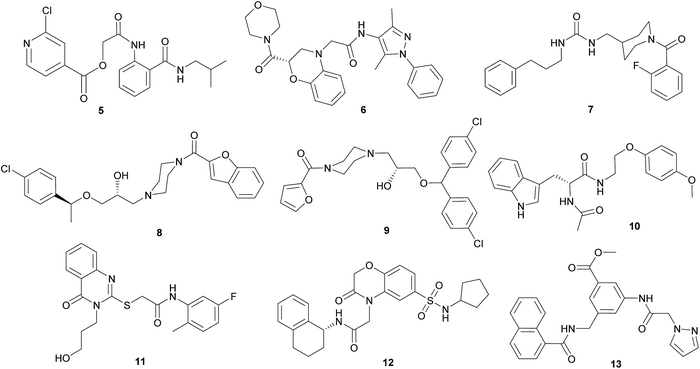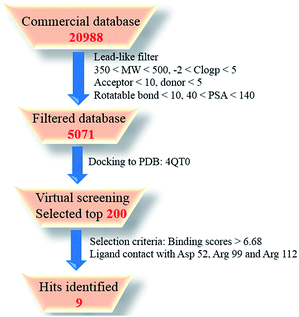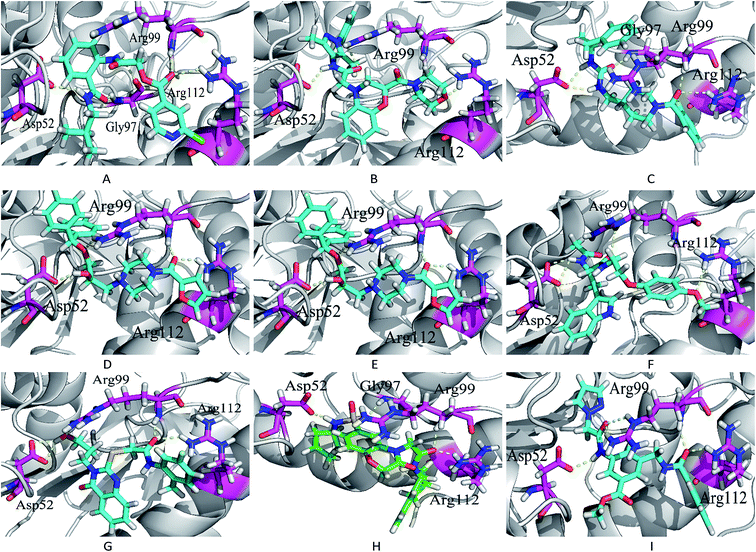Discovery of a novel human lactate dehydrogenase A (LDHA) inhibitor as an anti-proliferation agent against MIA PaCa-2 pancreatic cancer cells†
Yunpeng Suna,
Chonglin Taoa,
Fuxiang Yua,
Wenjun Yanga,
Yunfeng Shana,
Zhengping Yua,
Hongqi Shia,
Mengtao Zhoua,
Qiyu Zhang*a and
Huanhuan Wu*b
aDepartment of Hepatobiliary Surgery, The First Affiliated Hospital of Wenzhou Medical University, China
bDepartment of Infectious Disease, The First Affiliated Hospital of Wenzhou Medical University, China. E-mail: HuanhuanWu007@gmail.com
First published on 22nd February 2016
Abstract
LDHA has recently emerged as an attractive target for cancer therapy. Herein, we present the discovery of a potent LDHA inhibitor 12, which has good inhibitory activity to LDHA (IC50 = 1.50 μM). Moreover, the inhibitor 12 strongly inhibits the proliferation of MIA PaCa-2 pancreatic cancer cells (EC50 = 3.16 μM), suggesting it could serve as a promising candidate for further investigation.
Pancreatic cancer is the seventh, fifth, and fourth leading cause of cancer related deaths in China, the European Union and the United States, respectively.1,2 Large population-based research has indicated that the overall 5 year survival rate in patients with pancreatic cancer remains below 5%.3 Therefore, it is urgent to discover novel therapeutic agents against pancreatic cancer. Recently, some groups reported that the expression of human lactate dehydrogenase A (LDHA) was elevated in pancreatic cancer cells. The increased expression promotes the growth of pancreatic cancer cells,4,5 while knocking down LDHA inhibits the growth of pancreatic cancer cells dramatically. Taken together, discovery potent chemotherapeutic agents targeting LDHA to impede pancreatic cancer cells' growth and proliferation could be exploited for the treatment of pancreatic cancer.
LDHA (known as LDH-5) catalyzes the final step of aerobic glycolysis, using the reduced nicotinamide adenine dinucleotide (NADH) as a co-factor to transfer a hydride to pyruvate ketone moiety.6 While another isoform lactate dehydrogenase B (LDHB, known as LDH-1) can also effect this transformation, it preferentially catalyzes the reverse reaction in which lactate is converted to pyruvate.7 It has been known that LDHA is over-expressed in human tumor tissues and was found to correlate with tumor size and poor prognosis.8–10
Until now, a number of LDHA inhibitors have been disclosed (see Fig. 1). Gossypol, a natural polyphenol dialdehyde extracted from cotton seeds, is a potent LDHA inhibitor, but its cytotoxicity to normal cells appears to limit the further clinical application.11 Another known LDHA inhibitor FX11, with a Ki value of 8 μM, was proved to inhibit the tumor progression in vitro and in vivo.12 N-Hydroxyindole-based compounds 1a–c are types of promising LDHA selective inhibitors, which also showed inhibitory activities toward a wide range of tumor cells including the primary pancreatic cancer cells. Particularly, they displayed even stronger anti-proliferation activities under hypoxic condition, with EC50 values of 0.36, 0.10 and 0.90 μM, respectively.13 Inhibitors 2–4 were reported to show inhibitory activities at very low micromolar and nanomolar ranges, but the authors reported limited cellular activities or the inhibitors were not suitable for studying the pharmacokinetics.8,14 Herein, we present a virtual screening approach that allowed us to identify new LDHA inhibitors with interesting inhibitory potencies in vitro enzymatic and anti-proliferation assays.
The workflow of the virtual screening procedures was shown in Fig. 2. Firstly, the crystal structure of human LDHA bound to compound 3 (PDB entry 4QT0) was employed for molecular docking. The structure was selected because of its clear electron density for structure-based drug design.14 The protein structure was optimized in protein preparation workflow of Sybyl-X 2.0 software package. Secondly, a chemical library with 20988 commercially available compounds was download from ZINC database. The library was filtered to discard compounds with unfavorable physicochemical properties that do not follow the drug-like rules (350 < molecular weight < 500, −2 < C![[thin space (1/6-em)]](https://www.rsc.org/images/entities/char_2009.gif) log
log![[thin space (1/6-em)]](https://www.rsc.org/images/entities/char_2009.gif) p < 5, 0 < rotational bonds < 10, 0 < donor < 5, 0 < acceptor < 10, 40 < polar surface area < 140), then the remaining 5071 compounds were optimized by the ligand structure preparation procedure in the software. Finally, the prepared compounds were docked into the binding pocket of compound 3 in LDHA using Surflex-Dock software. The top-ranked 200 compounds with the highest binding scores were selected, desired compounds were picked from the 200 compounds if satisfying the following two criteria: one is the binding score higher than 6.68, which was calculated from the interaction between compound 3 and LDHA (PDB code: 4QT0). The other one is that compounds form no less than three hydrogen bonds with residues Arg 99, Asp 52, Arg 112 or Gly 97 of LDHA in the docking model. Following the two rules, 9 candidates (see Fig. 3) were identified and purchased for further biochemical validation.
p < 5, 0 < rotational bonds < 10, 0 < donor < 5, 0 < acceptor < 10, 40 < polar surface area < 140), then the remaining 5071 compounds were optimized by the ligand structure preparation procedure in the software. Finally, the prepared compounds were docked into the binding pocket of compound 3 in LDHA using Surflex-Dock software. The top-ranked 200 compounds with the highest binding scores were selected, desired compounds were picked from the 200 compounds if satisfying the following two criteria: one is the binding score higher than 6.68, which was calculated from the interaction between compound 3 and LDHA (PDB code: 4QT0). The other one is that compounds form no less than three hydrogen bonds with residues Arg 99, Asp 52, Arg 112 or Gly 97 of LDHA in the docking model. Following the two rules, 9 candidates (see Fig. 3) were identified and purchased for further biochemical validation.
 | ||
| Fig. 3 Chemical structures of the potential compounds identified from the virtual screening approach. | ||
The 9 candidates and the reference compound 3 were tested for their inhibitory activities on purified human LDHA isoform by measuring the disappearance of NADH during the conversion of pyruvate to lactate. As shown in Table 1, most of the identified compounds displayed a satisfactory inhibition to LDHA, the IC50 values range from 1.5 to 38.4 μM (see Table 1). Compound 12 gave the most potency against LDHA, with the IC50 value of 1.5 μM, much better than the reference compound 3. The elevated inhibition against LDHA could be partially explained by the evidence obtained from our docking experiment (Fig. 4). Similar to compound 3, the identified compounds 5, 7 and 12 also retained the hydrogen bond interactions with residues Asp 52, Gly 97, Arg 99 and Arg 112 of LDHA, which gave rise to decent binding scores (see Table 1). Interestingly, the three compounds displayed stronger potencies to LDHA than others in our enzyme inhibition assay.
| Comp. | LDHA inhibition | Anti-proliferation ratesb (%) on MIA PaCa-2 cells at 20 μM | Binding scoresc |
|---|---|---|---|
| IC50a (μM) | |||
| a LDHA inhibition data were reported as the arithmetic mean of three separate runs.b Anti-proliferation rates (%) are from cytotoxicity experiments by treatment of the identified compounds at 20 μM.c Binding scores were obtained by docking software (Sybyl-X 2.0). | |||
| 5 | 11.3 ± 1.54 | 72.0% | 7.63 |
| 6 | 38.4 ± 1.66 | 47.1% | 7.43 |
| 7 | 2.33 ± 0.31 | 72.3% | 8.56 |
| 8 | 29.7 ± 3.35 | No inhibition | 8.14 |
| 9 | 16.4 ± 2.06 | 21.5% | 7.49 |
| 10 | 7.0 ± 0.93 | 62.7% | 7.91 |
| 11 | 23.9 ± 1.67 | 54.2% | 7.78 |
| 12 | 1.5 ± 0.21 | 95.3% | 8.76 |
| 13 | 9.21 ± 1.09 | 37.7% | 8.15 |
| 3 | 20.31 ± 2.51 | 23.4% | 6.68 |
With the potent compounds in hand, next we have interest to address the question whether our identified compounds inhibit the growth of MIA PaCa-2 pancreatic cancer cells. We tested the anti-proliferation activities of the identified compounds on the MIA PaCa-2 pancreatic cancer cells by using MTT assay. As shown in Table 1, most of the compounds, especially for compounds 5, 7 and 10, with the inhibition rates at 72.0%, 72.3% and 62.7%, blocked the MIA PaCa-2 pancreatic cancer cells proliferation at 20 μM. Of note, compound 12, with the EC50 value of 3.16 μM (see Fig. 5A), strongly inhibited the growth of the cancer cells at 20 μM. In order to study the mode of the MIA PaCa-2 pancreatic cancer cells death, compound 12 was used to induce MIA PaCa-2 pancreatic cancer cells apoptosis and examined by Annexin VFITC/PI FACS assay. As shown in Fig. 5B, the percentages of apoptosis for MIA PaCa-2 pancreatic cancer cells treated with compound 12 at 5, 10 and 15 μM for 10 h were 5.07%, 11.70% and 16.20%, respectively, suggesting the induction of apoptosis in MIA PaCa-2 pancreatic cancer cells by compound 12 follows a dose-dependent manner.
Because compound 12 exhibited the most potency to inhibit MIA PaCa-2 pancreatic cancer cells proliferation, it also displayed a promising inhibitory activity towards LDHA, so we would like to further study this compound. Inhibition of LDHA results in the switch of pyruvate consumption from lactate production to oxidative phosphorylation in the mitochondrion, the switch will lead to the changes of oxygen consumption and the degree of acidification in cancer cells. So the metabolic modulatory effect of compound 12 on MIA PaCa-2 pancreatic cancer cells was evaluated by measuring the formation of lactate, oxygen consumption (OCR) and extracellular acidification (ECAR). As shown in Fig. 6A, the lactate formation was significantly decreased in MIA PaCa-2 cells after treatment of compound 12. OCR was increased with the addition of various concentrations of compound 12 (see Fig. 6B), suggesting more of the mitochondrial respiration for MIA PaCa-2 pancreatic cancer cells after the treatment of compound 12. ECAR was decreased, which was consistent with the lactate production changes (see Fig. 6C).
Conclusions
In summary, we have successfully discovered a potent LDHA inhibitor through the virtual screening approach and biochemical assays. The identified inhibitor 12 was tested by in vitro enzymatic and anti-proliferation assays, which suggested compound 12 targeting LDHA with cellular activity. Bioenergetics profile experiments revealed compound 12 could serve as a modulator to reprogram MIA PaCa-2 cells metabolism from glycolysis to mitochondrial respiration. To the best of our knowledge, inhibitor 12 was the first time reported targeting LDHA with cellular activity.Acknowledgements
We thank the financial support from Education Department of Zhejiang Province (project reference no. Y201534189 and Y20150059).Notes and references
- J. Ferlay, D. M. Parkin and E. Steliarova-Foucher, Eur. J. Cancer, 2010, 46, 765–781 CrossRef CAS PubMed.
- J. F. Luo, L. H. Xiao, C. X. Wu, Y. Zheng and N. Q. Zhao, PLoS One, 2013, 8, e76052 CrossRef CAS PubMed.
- M. K. Lau, J. A. Davila and Y. H. Shaib, Pancreas, 2010, 39, 458–462 CrossRef PubMed.
- J. Cui, M. Shi, D. Xie, D. Wei, Z. Jia, S. Zheng, Y. Gao, S. Huang and K. Xie, Clin. Cancer Res., 2014, 20, 2595–2606 CrossRef CAS PubMed.
- Y. Rong, W. Wu, X. Ni, T. Kuang, D. Jin, D. Wang and W. Lou, Tumour Biol., 2013, 34, 1523–1530 CrossRef CAS PubMed.
- C. J. Valvona, H. L. Fillmore, P. B. Nunn and G. J. Pilkington, Brain Pathol., 2016, 26, 3–17 CrossRef CAS PubMed.
- (a) J. A. Read, V. J. Winter, C. M. Eszes, R. B. Sessions and R. L. Brady, Proteins, 2001, 43, 175–185 CrossRef CAS PubMed; (b) C. Granchi, S. Bertini, M. Macchia and F. Minutolo, Curr. Med. Chem., 2010, 17, 672–697 CrossRef CAS PubMed.
- (a) Y. Kolev, H. Uetake, Y. Takagi and K. Sugihara, Ann. Surg. Oncol., 2008, 15, 2336–2344 CrossRef PubMed; (b) R. D. Goldman, N. O. Kaplan and T. C. Hall, Cancer Res., 1964, 24, 389–399 CAS.
- (a) M. I. Koukourakis, A. Giatromanolaki, E. Sivridis, K. C. Gatter and A. L. Harris, J. Clin. Oncol., 2006, 24, 4301–4308 CrossRef CAS PubMed; (b) A. Giatromanolaki, E. Sivridis, K. C. Gatter, H. Turley, A. L. Harris and M. I. Koukourakis, Gynecol. Oncol., 2006, 103, 912–918 CrossRef CAS PubMed.
- (a) M. I. Koukourakis, A. Giatromanolaki, E. Sivridis, G. Bougioukas, V. Didilis, K. C. Gatter and A. L. Harris, Br. J. Cancer, 2003, 89, 877–885 CrossRef CAS PubMed; (b) S. L. Sheng, J. J. Liu, Y. H. Dai, X. G. Sun, X. P. Xiong and G. Huang, FEBS J., 2012, 279, 3898–3910 CrossRef CAS PubMed.
- (a) S. R. Choi, A. Pradhan, N. L. Hammond, A. G. Chittiboyina, B. L. Tekwani and M. A. Avery, J. Med. Chem., 2007, 50, 3841–3850 CrossRef CAS PubMed; (b) D. L. Vander Jagt, L. M. Deck and R. E. Royer, Curr. Med. Chem., 2000, 7, 479–498 CrossRef CAS PubMed.
- A. Le, C. R. Cooper, A. M. Gouw, R. Dinavahi, A. Maitra, L. M. Deck, R. E. Royer, D. L. Vander Jagt, G. L. Semenza and C. V. Dang, Proc. Natl. Acad. Sci. U. S. A., 2010, 107, 2037–2042 CrossRef CAS PubMed.
- C. Granchi, S. Roy, C. Giacomelli, M. Macchia, T. Tuccinardi, A. Martinelli, M. Lanza, L. Betti, G. Giannaccini, A. Lucacchini, N. Funel, L. G. León, E. Giovannetti, G. J. Peters, R. Palchaudhuri, E. C. Calvaresi, P. J. Hergenrother and F. Minutolo, J. Med. Chem., 2011, 54, 1599–1612 CrossRef CAS PubMed.
- (a) P. S. Dragovich, B. P. Fauber, L. B. Corson, C. Z. Ding, C. Eigenbrot, H. Ge, A. M. Giannetti, T. Hunsaker, S. Labadie, Y. Liu, S. Malek, B. Pan, D. Peterson, K. Pitts, H. E. Purkey, S. Sideris, M. Ultsch, E. VanderPorten, B. Wei, Q. Xu, I. Yen, Q. Yue, H. Zhang and X. Zhang, Bioorg. Med. Chem. Lett., 2013, 23, 3186–3194 CrossRef CAS PubMed; (b) R. A. Ward, C. Brassington, A. L. Breeze, A. Caputo, S. Critchlow, G. Davies, L. Goodwin, G. Hassall, R. Greenwood, G. A. Holdgate, M. Mrosek, R. A. Norman, S. Pearson, J. Tart, J. A. Tucker, M. Vogtherr, D. Whittaker, J. Wingfield, J. Winter and K. Hudson, J. Med. Chem., 2012, 55, 3285–3306 CrossRef CAS PubMed; (c) S. Kolappan, D. L. Shen, R. Mosi, J. Sun, E. J. McEachern, D. J. Vocadlo and L. Craig, Acta Crystallogr., Sect. D: Biol. Crystallogr., 2015, 71, 185–195 CrossRef CAS PubMed.
Footnote |
| † Electronic supplementary information (ESI) available: Experimental procedures for cell culture, anti-proliferation assay, apoptosis detection by flow cytometry, lactate measurement, Seahorse XF24 experiment, LDHA enzymatic assay, molecular docking procedures. See DOI: 10.1039/c5ra27736a |
| This journal is © The Royal Society of Chemistry 2016 |





